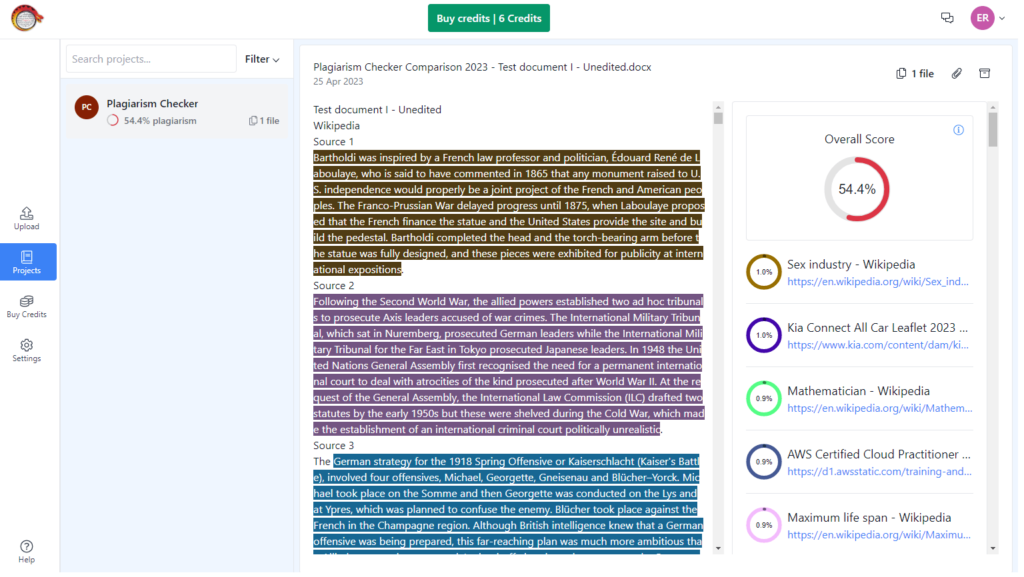Understanding AI Checking Requirements
For AI checking to ensure compliance, several specific requirements must be met, beginning with file size limitations. The most stringent constraint is that files must be under 100 MB. This limitation is crucial for the efficient processing of large volumes of data by AI systems, ensuring that they can handle and analyze content rapidly without burdening system resources. Alongside file size, the content itself must meet certain criteria.
One of the primary requirements is that files should contain at least 300 words of prose text, ideally in long-form writing formats. This stipulation ensures that the AI has sufficient material to accurately evaluate for plagiarism and compliance issues. Short snippets or fragmented content, such as lists or bullet points, do not provide the necessary context for thorough analysis. Similarly, unconventional writing styles such as poetry, scripts, or bullet points are not suitable for AI checking. These formats can often hinder the AI’s ability to discern context and meaning, leading to inaccurate assessments.
Moreover, document length is another critical requirement. Files that are to be processed should not exceed 15,000 words. This upper limit ensures that the document remains manageable for AI systems to evaluate without compromising efficiency or accuracy. Coupled with word count and file size requirements, specific file types are also mandated. Accepted formats include .docx, .pdf, .txt, and .rtf. These formats are standard in digital documentation and possess features that facilitate easier parsing and processing by AI systems.
By adhering to these requirements—such as maintaining an appropriate file size, ensuring the text meets minimum word counts, avoiding unconventional writing styles, and using acceptable file formats—one can effectively leverage AI tools for checking and plagiarism detection. This rigorous standardization facilitates accurate, reliable outcomes while optimizing the performance of the AI systems employed.
Guidelines for Plagiarism Detection
When submitting documents for plagiarism detection, adherence to specific prerequisites is paramount to ensure systematic and efficient processing. Key among these is the requirement for the document file size to remain under 100 MB. This ensures that the system can handle the document effectively without unnecessary lag or crashes that could impede the evaluation process.
Equally important is the inclusion of a minimum of 20 words of text in the document. This requisite ensures that there is sufficient content for the plagiarism detection algorithm to analyze, thereby providing accurate and reliable results. Documents should also not exceed a length of 400 pages. Keeping within this limit helps maintain the integrity of the processing system, ensuring it remains functional and efficient.
Understanding the flexible nature of document creation, multiple file formats are supported. Acceptable formats include Microsoft Word, PowerPoint, PDF, OpenOffice (ODT), and plain text. This diversity in format support allows users the convenience of submitting documents in their preferred format without needing to convert files, thereby saving time and reducing the potential for formatting errors.
Additionally, the plagiarism detection system is designed to support a range of languages, ensuring inclusivity and widening its usability. Supported languages include, but are not limited to, English, Malay, Chinese, Arabic, Thai, Korean, Japanese, and Spanish. This multilingual capability caters to a global user base, making the plagiarism detection process accessible to non-English speakers and facilitating the evaluation of content across diverse linguistic contexts.
Common Issues and How to Avoid Them
Submitting files for AI checking and plagiarism detection can sometimes be fraught with issues that impede the accuracy and efficiency of these evaluations. Identifying and addressing these common problems is crucial to ensure a smooth and precise analysis.
One of the most frequent issues is the use of unsuitable text formats. Not all formats are compatible with AI checkers, and certain formatting decisions can confuse the algorithms, leading to inaccurate assessments. To avoid this, submit your documents in widely accepted formats like .doc, .docx, or .pdf. Avoid using formats like .jpg or .png, which are image-based and not conducive to text analysis.
Another common problem is excessively large file sizes. Large documents can slow down the AI’s processing speed and may even cause errors in file uploads or analysis. It’s essential to optimize your file size without compromising content quality. This can be achieved by compressing images, removing unnecessary graphics, and ensuring the text is concise. Tools like file compressors or PDF optimizers can be highly effective in maintaining a manageable file size.
Verifying word and page counts is another critical aspect often overlooked. AI systems often have limitations on the volume they can handle efficiently. Double-check the requirements of the AI tool you are using and ensure your document meets those specifications before submission. This practice not only facilitates better processing but also helps in obtaining more accurate results.
In addition, one must ensure the use of compatible file types. AI checkers are designed to work best with certain types of documents, so it’s essential to use text-based files rather than images or other incompatible formats. This enhances the system’s ability to perform a thorough examination and return precise feedback.
Lastly, always ensure your text is long-form prose as required. AI checkers are optimized to assess continuous, structured text. Using bullet points or non-prose formats can hinder the evaluation process. Maintaining a consistent narrative flow helps the AI system to better comprehend and analyze the content.
By addressing these issues thoughtfully, users can significantly improve the efficiency and accuracy of AI checking and plagiarism detection processes, leading to more reliable and insightful outcomes.
Terms, Conditions, and Best Practices
When utilizing AI checking and plagiarism detection services, it is imperative to comprehend and adhere to the established terms and conditions. Users are required to accept these stipulations, ensuring a transparent and accountable transaction. The terms outline the specific requirements for submitting documents, including file format, length, and acceptable content types. Any deviation from these criteria could lead to non-compliance, with serious repercussions.
One crucial aspect of these services is the policy of no refunds or replacements for issues stemming from non-compliance. Users must be fully aware that once they submit their documents, adherence to the terms is their responsibility. Therefore, thorough preparation is essential to avoid any pitfalls. Ensure that files meet all stipulated guidelines before submission. It is advisable to meticulously review the requirements provided by the service provider to mitigate the risk of rejection or processing delays.
Best practices in preparing and submitting files involve several key steps. Practitioners should ensure that documents are free of formatting issues, such as corrupted files or incompatible file types. Adhering to the recommended file formats, usually DOCX, PDF, or TXT, can facilitate smoother processing by the AI systems. Additionally, maintaining concise and relevant content within the specified limits will help prevent rejection due to length constraints.
Avoiding pitfalls during submission also entails vigilance in reviewing the document for completeness and clarity. Confirming that the content is free of confidential or sensitive information is crucial, as breaches of privacy terms can result in severe consequences. Lastly, double-checking the document’s originality prior to submission can enhance the reliability of the plagiarism detection results.
Ultimately, ensuring compliance with the terms and conditions and following best practices significantly contributes to the efficient and effective utilization of AI checking and plagiarism detection services. Such diligence not only safeguards against non-compliance issues but also promotes a seamless and satisfactory user experience.
❗ 𝐀𝐭𝐭𝐞𝐧𝐭𝐢𝐨𝐧 𝐟𝐨𝐫 𝐀𝐈 𝐂𝐡𝐞𝐜𝐤𝐢𝐧𝐠 ❗
➡ File size must be 𝐥𝐞𝐬𝐬 𝐭𝐡𝐚𝐧 𝟏𝟎𝟎 𝐌𝐁 ➡ File must have 𝐚𝐭 𝐥𝐞𝐚𝐬𝐭 𝟑𝟎𝟎 𝐰𝐨𝐫𝐝𝐬 𝐨𝐟 𝐩𝐫𝐨𝐬𝐞 𝐭𝐞𝐱𝐭 𝐢𝐧 𝐚 𝐥𝐨𝐧𝐠 𝐟𝐨𝐫𝐦 𝐰𝐫𝐢𝐭𝐢𝐧𝐠 𝐟𝐨𝐫𝐦𝐚𝐭 ➡ 𝐍𝐨𝐭𝐞: 𝐏𝐨𝐞𝐭𝐫𝐲, 𝐬𝐜𝐫𝐢𝐩𝐭𝐬 𝐨𝐫 𝐜𝐨𝐝𝐞, 𝐬𝐡𝐨𝐫𝐭/𝐮𝐧𝐜𝐨𝐧𝐯𝐞𝐧𝐭𝐢𝐨𝐧𝐚𝐥 𝐰𝐫𝐢𝐭𝐢𝐧𝐠 (𝐬𝐮𝐜𝐡 𝐚𝐬 𝐛𝐮𝐥𝐥𝐞𝐭 𝐩𝐨𝐢𝐧𝐭𝐬 𝐨𝐫 𝐚𝐧𝐧𝐨𝐭𝐚𝐭𝐞𝐝 𝐛𝐢𝐛𝐥𝐢𝐨𝐠𝐫𝐚𝐩𝐡𝐢𝐞𝐬) 𝐝𝐨 𝐧𝐨𝐭 𝐜𝐨𝐮𝐧𝐭 𝐭𝐨𝐰𝐚𝐫𝐝𝐬 𝐭𝐡𝐞 𝐰𝐨𝐫𝐝 𝐜𝐨𝐮𝐧𝐭. ➡ Files must 𝐧𝐨𝐭 𝐞𝐱𝐜𝐞𝐞𝐝 𝟏𝟓,𝟎𝟎𝟎 𝐰𝐨𝐫𝐝𝐬 ➡ File must be written in 𝐄𝐧𝐠𝐥𝐢𝐬𝐡 ➡ Accepted file types: .𝐝𝐨𝐜𝐱, .𝐩𝐝𝐟, .𝐭𝐱𝐭, .𝐫𝐭𝐟
❗ 𝐀𝐭𝐭𝐞𝐧𝐭𝐢𝐨𝐧 𝐟𝐨𝐫 𝐏𝐥𝐚𝐠𝐢𝐚𝐫𝐢𝐬𝐦 𝐂𝐡𝐞𝐜𝐤𝐢𝐧𝐠❗
➡ File size must be 𝐥𝐞𝐬𝐬 𝐭𝐡𝐚𝐧 𝟏𝟎𝟎 𝐌𝐁 ➡ Files must have 𝐚𝐭 𝐥𝐞𝐚𝐬𝐭 𝟐𝟎 𝐰𝐨𝐫𝐝𝐬 𝐨𝐟 𝐭𝐞𝐱𝐭 ➡ The maximum paper length is 𝟒𝟎𝟎 𝐩𝐚𝐠𝐞𝐬 ➡ File types allowed: 𝐌𝐢𝐜𝐫𝐨𝐬𝐨𝐟𝐭 𝐖𝐨𝐫𝐝, 𝐏𝐨𝐰𝐞𝐫𝐏𝐨𝐢𝐧𝐭, 𝐏𝐃𝐅, 𝐎𝐩𝐞𝐧𝐎𝐟𝐟𝐢𝐜𝐞 (𝐎𝐃𝐓),
𝐩𝐥𝐚𝐢𝐧 𝐭𝐞𝐱𝐭, 𝐞𝐭𝐜 ➡ Supported languages: 𝐄𝐧𝐠𝐥𝐢𝐬𝐡, 𝐌𝐚𝐥𝐚𝐲, 𝐂𝐡𝐢𝐧𝐞𝐬𝐞, 𝐀𝐫𝐚𝐛𝐢𝐜, 𝐓𝐡𝐚𝐢, 𝐊𝐨𝐫𝐞𝐚𝐧, 𝐉𝐚𝐩𝐚𝐧𝐞𝐬𝐞, 𝐒𝐩𝐚𝐧𝐢𝐬𝐡, 𝐞𝐭𝐜. ⚠ 𝐃𝐢𝐬𝐜𝐥𝐚𝐢𝐦𝐞𝐫⚠ Please adhere to the AI checking requirements. Refunds or replacement will not be issued for issues arising on your end, as the requirements are clearly stated. One order is valid for one file and one-time checking. No physical goods will be shipped.
✅By purchasing this service, you agree to our terms and conditions and buyer need to bear consequences (strictly no refund.)
Normal Option
🟨 Normal: First come, first serve. This option ensures that your request is processed in the order it was received. Ideal for non-urgent needs.
Urgent (ASAP) Option
🟩 Urgent (ASAP): Prioritize processing if there are many orders. Opt for this service when you need quick turnaround and immediate attention.
Plagiarism and AI Percentage Reports
🟥 Plagiarism AI Percentage: Includes a plagiarism report and AI percentage without highlighted AI context. 🟦 Only AI Percentage: Provides only the AI percentage without highlighted context and plagiarism. ⬜ AI Report: Including AI percentage and highlighted context. 🟪 Plagiarism AI Report: Includes plagiarism report and AI report with percentage and highlighted context.
1 Day Account Access
🟫 1 Day Account: We will provide an account so that you can check for plagiarism by yourself unlimited times within a day. Note, no AI detection is included in this option.









